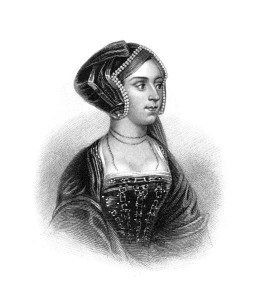 On 29th April 1536, Queen Anne Boleyn had two encounters which would be twisted and used as evidence against her.
On 29th April 1536, Queen Anne Boleyn had two encounters which would be twisted and used as evidence against her.
The first involved musician Mark Smeaton. According to Mrs Stonor, one of the ladies chosen to attend Anne Boleyn during her imprisonment in the Tower, Anne said of Smeaton:
“I never spake with him since, but upon Saturday before May-day [29th April], and then I found him standing in the round window in my chamber of presence; and I asked why he was so sad? And he answered and said it was no matter. And then I said, You may not look to have me speak to you as I should do to a noble man, because ye be an inferior person. No, no, said he, a look sufficeth me; and thus fare you well.”1
Anne’s account suggests that Smeaton had a crush on her, but that she put him in his place by pointing out his lowly status. John Strype, the 18th century historian, wondered if it was Anne’s reaction to him which made Smeaton want to “take this opportunity to humble her; and revenge himself”.2 Whatever the truth of the matter, Smeaton was apprehended the next day and confessed to sleeping with the Queen on three occasions.
Also on 29th April Anne Boleyn argued with Sir Henry Norris, her husband’s Groom of the Stool. Anne asked Norris why he was taking so long to marry Madge Shelton, her cousin, and when he gave her a non-committal answer she rebuked him, saying, “You look for dead men’s shoes, for if aught came to the King but good, you would look to have me”, thus accusing Norris of delaying his marriage to Madge because he fancied her. A horrified Norris replied that “if he [should have any such thought] he would his head were off.”3
Anne’s anger had caused her to speak recklessly. Not only had she said something very inappropriate for a married woman, let alone Queen; she had also spoken of the King’s death. The courtier was meant to proposition the lady; however, in this argument Anne could be seen as the ‘aggressor’. Norris was so horrified. Anne, realising what she had said, ordered him to go to her almoner and swear an oath about her character.
While Anne may have spoken recklessly, she was reprimanding Norris for his interest in her and could not be seen to be encouraging him in any way. And this conversation could certainly not be seen as evidence that she was conspiring with Norris to kill the king. The date of this conversation is not listed in the indictments of the Kent and Middlesex grand juries so it was not used against Anne and Norris.
Notes and Sources
- Cavendish, George (1825) The Life of Cardinal Wolsey, Volume 2, p37
- Strype, John (1816) Ecclesiastical Memorials Relating Chiefly to Religion, and the Reformation of It, and the Emergencies of the Church of England, Under King Henry VIII, King Edward VI, and Queen Mary I, Volume I, 436.
- LP x. 793